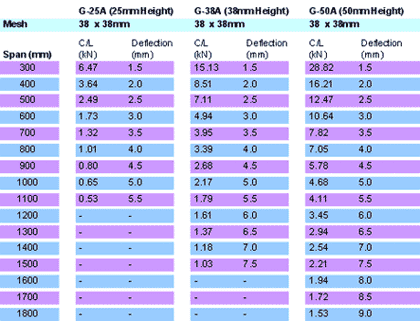
Mechanical & Physical
Properties of YEUNG'S G.R.P. Laminates
Testing Based on BS 2782 and carried out
by the University of Hong Kong
Material |
Grade |
Specific
Gravity |
Elastic
Modulus |
Proof Strength |
Impact
Strength |
Specific
Strength |
Specific
Modulus |
Tensile |
Compressive |
|
|
|
|
|
|
KJ/m2 |
MPa |
GPA |
Mild Steel |
B.S.I 5 |
7.8 |
207 |
240 |
240 |
50 |
31 |
27 |
Aluminium
Alloy |
HEI5WP |
2.7 |
69 |
417 |
417 |
25 |
154 |
26 |
Stainless Steel |
316 |
7.92 |
193 |
241 |
241 |
1356 |
30 |
34 |
GRP |
35% |
1.88 |
250 |
171 |
102 |
79.4 |
250 |
12.81 |
TABLE I - Indicative Figure of Mechanical
Properties of Dura GRP Material compared
with other construction materials.
Physical Properties
Test
|
Method
|
Result
|
Figure
|
Unit
|
| 1. Glass Content |
BS
2782 Part 10 Method 1002 |
35 |
% |
| 2. Flexural Strength / Elastic Modulus |
BS
2782 Part 10 Method 1005 |
250 |
N/mm2 |
| 3. Specific Gravity |
BS
2782 Method 620A |
1880 |
kg/m3 |
| 4. Tensile Strength |
BS
2782 Part 10 Method 1003-1983 |
171 |
N/mm2 |
| 5. Compressive
Strength |
BS
2782 Method 303B |
102 |
N/mm2 |
| 6. Barcol Hardness |
BS 2782 Part 10 Method 1001 |
35 |
|
| 7. Impact Strength |
BS 6206 |
79.4 |
KJ/m2 |
| 8. Flexural Modulus / Young's Modulus |
BS 2782 Part 10 Method 1005 |
12810 |
N/mm |
| 9.Tensile Modulus |
BS 2782 Part 10
Method 1003-1983 |
12600 |
N/mm |
| 10. Interlaminate shear strength |
BS 2782 Method 340A |
19.6 |
N/mm |
| 11.Thermal Conductivity |
BS 874 Part 2 -
1986 Sec 2.1 |
0.22 |
W/m deg C |
| 12. Thermal Expansion |
ASTM D696-79 or similar |
2.16 x 10-5 |
C |
| 13. Water Absorption |
BS 2782 Part 4
Method 430A-1983 |
0.18 |
% |
| 14. QCT Bilster Test |
1000 Hours at 55 deg C |
Satisfactory |
| 15. Water Quality
(For Tanks Only) |
BS 6920 |
Pass |
TABLE 2 - Manufacturer's Product Data of
physical properties for Dura GRP Material.
These products are ideally suited for
Gully Covers, Cat Walks, Bridges, Lightweight
Platforms and Mezzanine
 |
 |
| Corrosion
Resistance Information |
| DURA® grating
is resistant to the following
chemicals: |
Acetic Acid*
Alum
Aluminum Sulfate
Ammonium Carbonate
Ammonium Hydroxide*
Ammonium Nitrate
Ammonium Sulfate
Benzene Sulfuric Acid
Calcium Chloride
Calcium Hydroxide*
Calcium Hypochlorite*
Carbon Tetrachloride
Chlorine Dioxide*
Chlorine Gas
Chloroacetic Acid*
Chromic Acid*
Chromium Sulfate
Copper Chloride
Copper Nitrate
Copper Sulfate
Ethyl Alcohol*
Ethyl Chloride
Ethylene Glycol
Fatty Acids
Ferrous Acetate
Ferrous Chloride
Ferrous Nitrate
Ferrous Sulfate
Fluoboric Acid
Formaldehyde
Formic Acid
Hydrochloric Acid
Hydrobromic Acid*
Hydrocyanic Acid*
Hydrogen Peroxide*
Hydrogen Sulfide
Lactic Acid
|
Lead Acetate
Lead Nitrate
Magnesium Nitrate
Magnesium Sulfate
Mercuric Chloride
Methyl Alcohol*
Nickel Chloride
Nickel Nitrate
Nickel Sulfate
Nitric Acid*
Oxalic Acid
Perchloric Acid*
Phosphoric Acid*
Potassium Chloride
Potassium Cyanide
Potassium Dichromate
Potassium Nitrate
Potassium Sulfate
Propylene Glycol
Silver Nitrate
Sodium Acetate
Sodium Bromide
Sodium Carbonate*
Sodium Chloride
Sodium Citrate
Sodium Hydroxide*
Sodium Hypochlorite
Sodium Nitrate
Sodium Sulfate
Sodium Thiocyanate
Stearic Acid
Sulfite Liquors
Sulfur Dioxide
Sulfuric Acid*
Toluene
Urea-Ammonium Nitrate*
Zinc Chloride |
| * indicates that
a special resin is recommended
for this substance. |
| Contact
Us for more information
on the best solution for your
environment and conditions. |
|
|